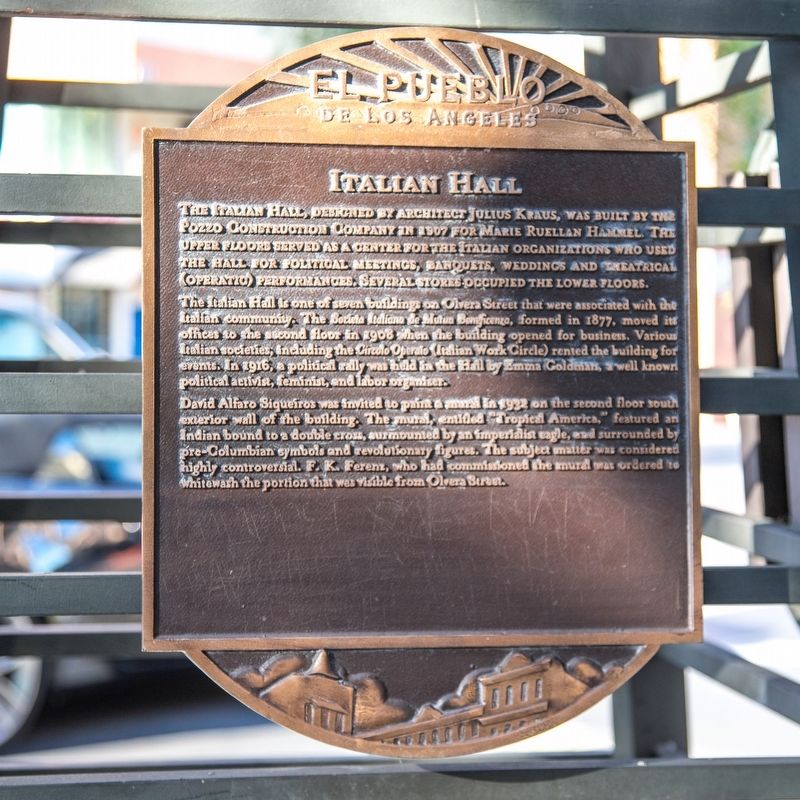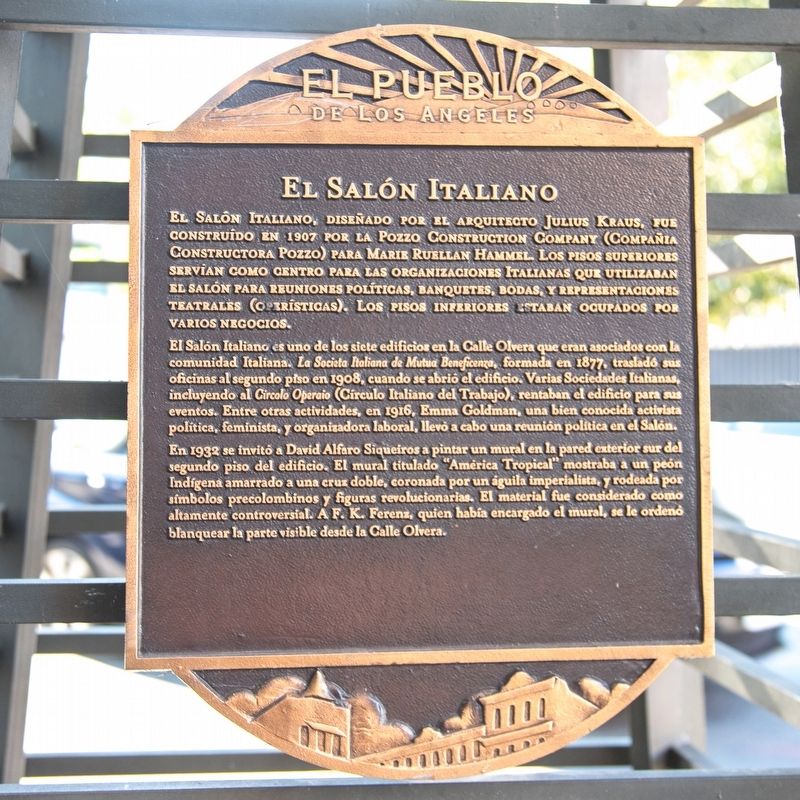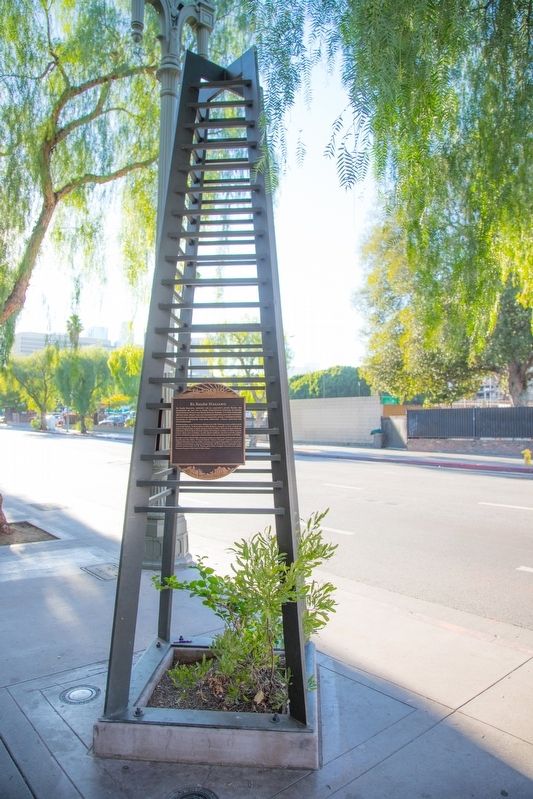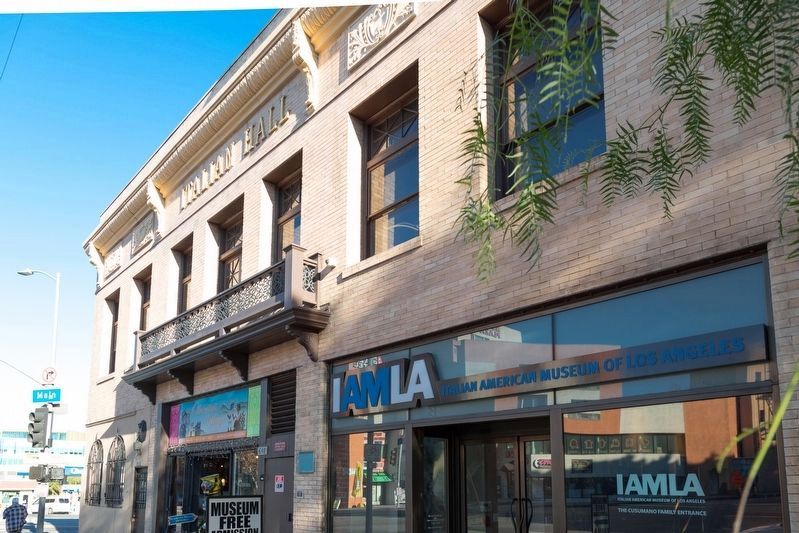Downtown Los Angeles in Los Angeles County, California — The American West (Pacific Coastal)
Italian Hall
El Salón Italiano
— El Pueblo de Los Angeles —
The Italian Hall is one of seven buildings on Olvera Street that were associated with the Italian community. The Socíeta Italiana de Mutua Beneficenza, formed in 1877, moved its offices to the second floor in 1908 when the building opened for business. Various Italian societies, including the Circolo Operaio (Italian Work Circle) rented the building for events. In 1916, a political rally was hend in the Hall by Emma Goldman, a well-known political activist, feminist, and labor organizer.
David Alfaro Siqueiros was invited to paint a mural in 1932 on the second floor south exterior wall of the building. The mural, entitle “Tropical America,” featured an Indian bound to a double cross surmounted by an imperialist eagle, and surrounded by pre-Columbian symbols and revolutionary figures. The subject matter was considered highly controversial. F.K. Ferenz, who had commissioned the mural was ordered to whitewash the portion that was visible from Olvera Street.
(plaque opposite)
El Salón Italiano es uno de los siete edificios en la Calle Olvera que eran asociados con la comunidad Italiana. La Socíeta Italiana de Mutua Beneficenza, formada en 1877, trasladó sus oficinas al segundo piso en 1908, cuando she abrió el edificio. Varias Sociedades Italianas, incluyendo al Circolo Operaio (Circulo Italiano de Trabajo), rentaban el edificio para sus eventos. Entre otras actividades, en 1916, Emma Goldman, una bien conocida activista política, feminista, y organizadora laboral, llevó a cabo una reunión política en el Salón.
En 1932 se invitó a David Alfaro Siqueiros a pintar un mural en la pared exterior sur del segundo piso del edificio. El mural titulado “América Tropical” mostraba a un peón Indígena amarrado a una cruz doble coronada por un águila imperialista, y rodeada por símbolos pre colombianos y figuras revolucionarias. El material fue considerado como altamente controversial. A F.K. Ferenz, quien había encargado el mural, se le ordenó blanquear la parte visible desde la Calle Olvera.
Erected by El Pueblo de Los Angeles.
Topics. This historical marker is listed in these topic lists: Entertainment • Fraternal or Sororal Organizations • Notable Buildings • Settlements & Settlers. A significant historical year for this entry is 1907.
Location. 34° 3.485′ N, 118° 14.275′ W. Marker is in Los Angeles, California, in Los Angeles County. It is in Downtown Los Angeles. Marker is at the intersection of North Main Street and Cesar E. Chavez Avenue, on the right when traveling north on North Main Street. Touch for map. Marker is at or near this postal address: 648 N Main st, Los Angeles CA 90012, United States of America. Touch for directions.
Other nearby markers. At least 8 other markers are within walking distance of this marker. A different marker also named Italian Hall (here, next to this marker); Hammel Building (a few steps from this marker); Charlie Chaplin’s The Kid (within shouting distance of this marker); Pelanconi Warehouse (within shouting distance of this marker); Sandstone Trough (within shouting distance of this marker); Pelanconi House & Pelanconi Warehouse (within shouting distance of this marker); 1932 Olympic Village Cottage (within shouting distance of this marker); Pelanconi House (within shouting distance of this marker). Touch for a list and map of all markers in Los Angeles.
Also see . . .
1. Italian Hall entry in Google Arts and Culture. The article on this page, by Marianna Gatto, is copiously illustrated with photographs from the Italian American Museum of Los Angeles. Excerpt:
Pozzo Construction’s expert craftsmanship is evident throughout the Italian Hall, from the ornate friezes on the exterior to the intricate mosaic entry, with its 7,000 tiles laid painstakingly by hand. On the building’s Main Street façade, the words “Italian Hall” were emblazoned in large, gold letters, and the flags of Italy and the United States were proudly displayed from the balcony.(Submitted on January 22, 2021.)
2. Wikipedia entry for David Alfaro Siqueiros. Excerpt:
Siqueiros’ other significant public Los Angeles mural, Tropical America (full name: América Tropical: Oprimida y Destrozada por los Imperialismos, or Tropical America:(Submitted on January 22, 2021.)Oppressed and Destroyed by Imperialism), was commissioned shortly after the unveiling of Street Meeting, and was to be painted on the exterior wall of the Plaza Art Center that faced the busy Olvera Street. Tropical America depicts the United States’ imperialism in Latin America, a much more radical theme than was intended for the work. Although it received generally favorable criticism, some viewed it as “Communist propaganda,” which led to a partial covering in 1934 and a total whitewash in 1938.
Eighty years later, the Getty Conservation Institute performed restoration work on the mural. As no color photographs of Tropical America are known to exist, conservators used scientific analysis and best practices to get at the artist’s vision of his piece. It became accessible to the public on its 80th anniversary, October 9, 2012. The América Tropical Interpretive Center that opened nearby is dedicated to the life and legacy of David Alfaro Siqueiros.
Credits. This page was last revised on January 30, 2023. It was originally submitted on January 22, 2021, by J. J. Prats of Powell, Ohio. This page has been viewed 203 times since then and 25 times this year. Photos: 1, 2, 3, 4. submitted on January 22, 2021, by J. J. Prats of Powell, Ohio.



